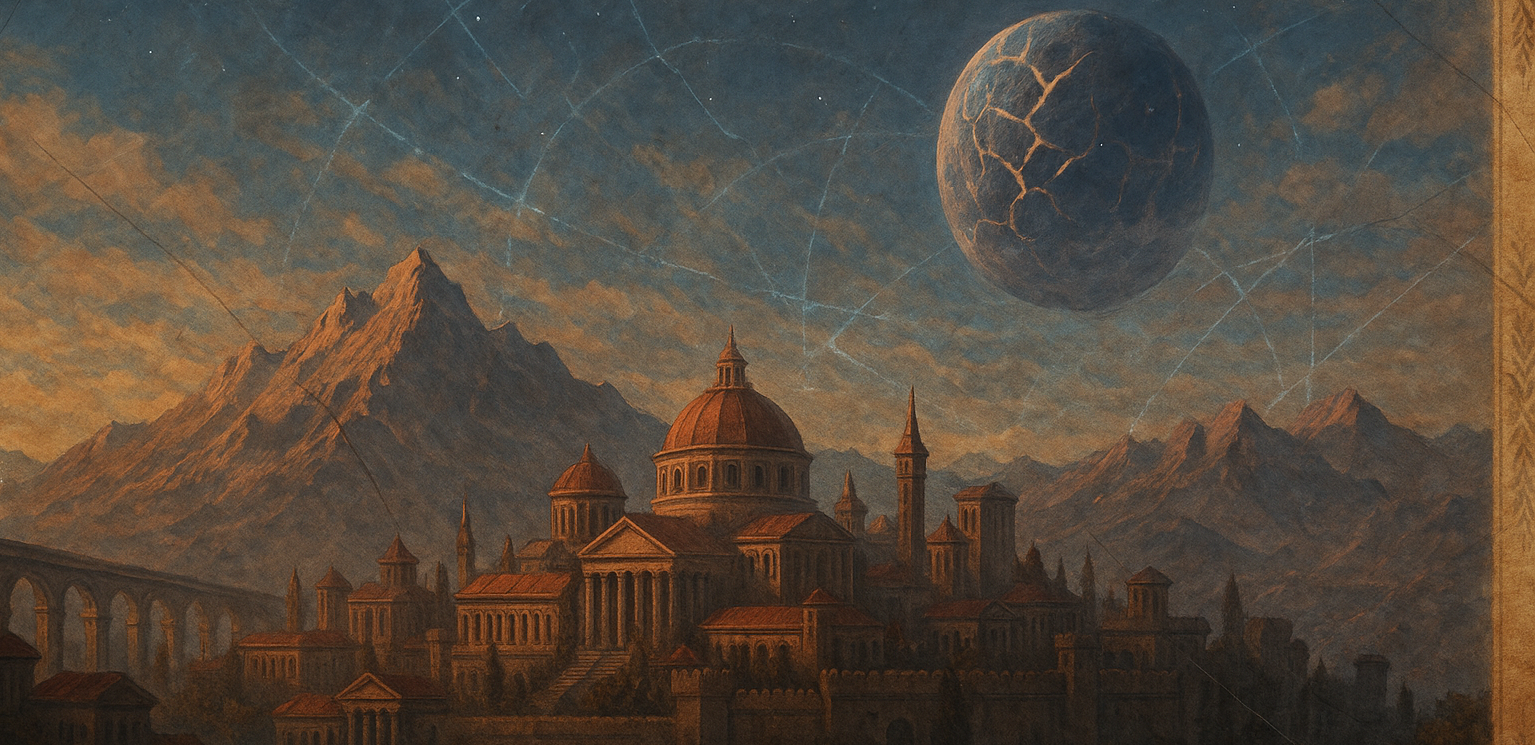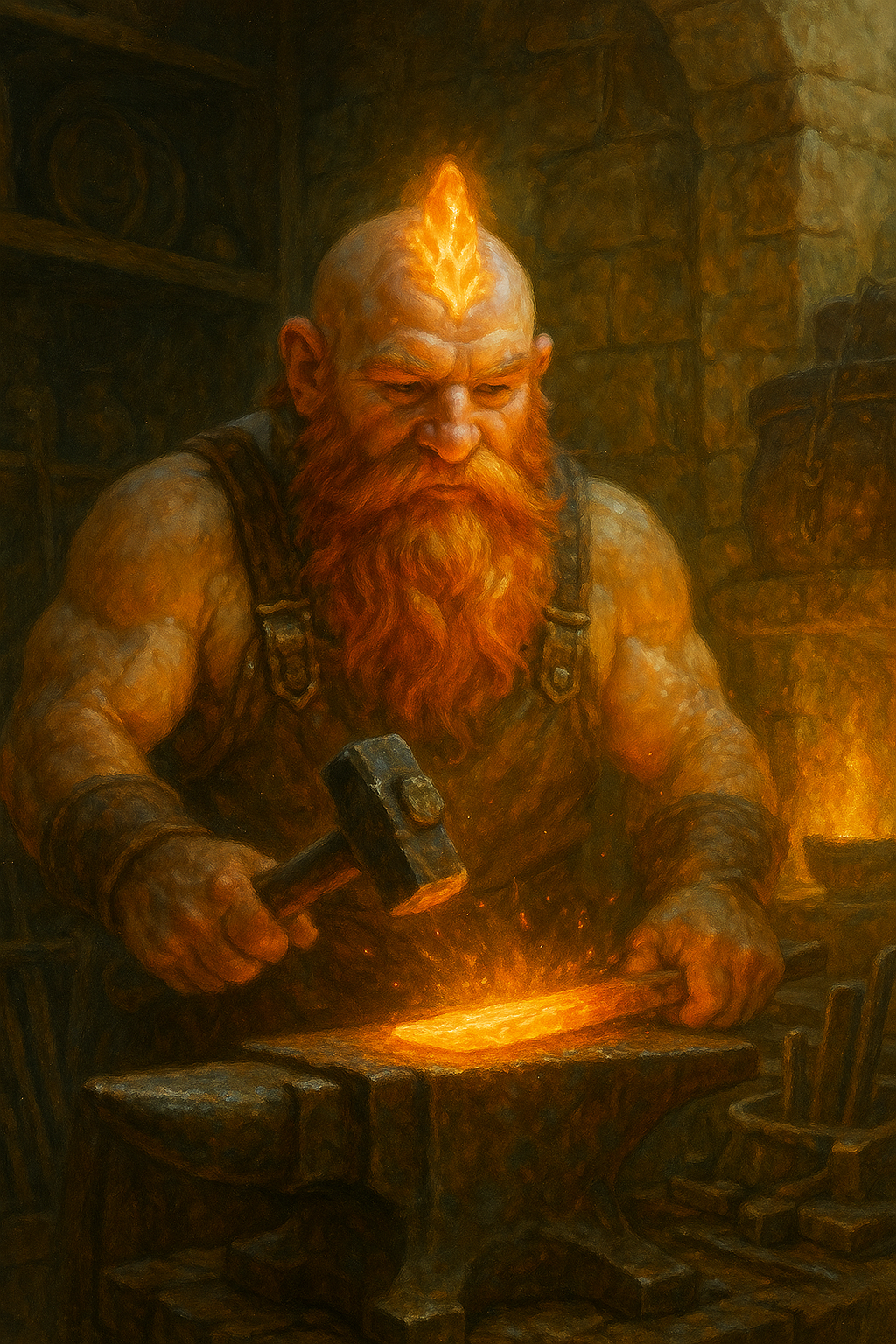The Riftforged Dwarves
Dwarves Who Temper Themselves Against the Rift
“The stone cracks. The Rift hums. We strike still.”
The Riftforged are a dwarven subculture that emerged after the Opening of the Rift, when some Ashfang dwarves chose to remain in the unstable regions near the Rift’s edge instead of retreating to safer, deeper halls. These pioneers adapted their craft to the volatile energies and alien materials emanating from the Rift, creating tools, weapons, and art that rival even the finest Imperial and dwarven creations. Their lives became a constant test of courage, ingenuity, and survival in an environment that was as likely to kill as it was to inspire. To outsiders, they are daring to the point of recklessness; to themselves, they are keepers of the flame — proof that no force, however strange, can master the dwarves.
Naming Traditions
Feminine names
Thaldra, Brizna, Kharna, Durmeya — often followed by epithets that evoke fire, crystal, or defiance.
Masculine names
Baruk, Graldan, Thargan, Dûrin — some adopting nicknames bestowed during apprenticeships, like Ashlung or Sparkblind.
Unisex names
Kazrak, Brûn, Thal, Vetra — these names are common among those who view their craft as more important than convention.
Family names
Riftforged dwarves carry the proud gens names of Ashfang lineage — Stonevein, Ironfist, Deepdelve — but often add epithets earned in the forge or mine, commemorating feats or scars: Emberborn, Shardhand, Flamebreaker, Veinwalker.
Other names
Some Riftforged take ceremonial names when mastering their craft, given by their peers and inscribed on their first completed Riftforged weapon or tool.
Culture
Major language groups and dialects
Upon entering another’s forge, one must bow slightly, present a scrap of worked metal, and wait for permission to approach. Heated disagreements are frequent but always resolved by day’s end, often through a symbolic strike of hammers on a shared anvil.
Culture and cultural heritage
They see themselves as a bridge between the predictable strength of stone and the unpredictable fury of the Rift. Their culture celebrates risk, ingenuity, and mastery — and insists that every craft, no matter how small, is an offering to both earth and Rift.
Shared customary codes and values
To waste even a scrap of metal or crystal dishonors both earth and ancestor. To abandon others during a collapse is unforgivable. To strike the forge in fear invites ruin. They believe every blow of the hammer is heard by the Rift itself.
Average technological level
Hybrid forging techniques that combine metal and Riftlight crystal, enchantments woven into steel, and mining methods that stabilize volatile seams.
Common Etiquette rules
On entering another’s forge, one must bow slightly and offer a scrap of metal before touching tools. Heated arguments are common but always resolved before the day’s end.
Common Dress code
Protective leathers reinforced with metal plates, sometimes dyed in the shimmering hues of Riftlight. Eye-mesh veils to shield against sparks, and belts hung with charms and shards of crystal to signal one’s rank and achievements.
Art & Architecture
Their halls are carved near the Rift’s edge, their walls veined with Riftlight that flickers at dusk. Statues depict fallen masters, and reliefs on the walls tell the story of the Riftforged through swirling patterns of stone and crystal. Even utilitarian bridges and buttresses are etched with glyphs and filigree.
Foods & Cuisine
Thick stews enriched with Rift-grown mushrooms and salted meats. Certain herbs impart mild hallucinogenic visions, considered sacred when taken during crafting.
Common Customs, traditions and rituals
At the annual First Ember festival, apprentices present ceremonial tools to the Master Warden and publicly recount their first brush with the Rift.
Birth & Baptismal Rites
Infants are carried into the forge at sunset, where elders trace protective glyphs on their foreheads in soot while whispering their name three times over the flames.
Coming of Age Rites
Upon reaching maturity, young Riftforged descend into the unstable Rift-edge seams to extract a live shard and forge it into their first personal tool before witnesses.
Funerary and Memorial customs
The dead are cremated, and their ashes are mixed into molten metal to forge memorial plaques set into the walls of the forge where they labored.
Common Taboos
Leaving a forge unattended during work, discarding flawed metal without ceremony, or mocking the dangers of the Rift are grave offenses, believed to invite disaster.
Common Myths and Legends
They tell of Dûrin Shardhand, who quenched a blade in pure Riftlight and disappeared into its glow, his hammer still heard in the night. The tale says he sought to capture the very essence of the Rift within steel, and when he struck his final blow, the blade screamed with light and swallowed him whole. Some claim to see his spectral figure walking the edge of the Rift on stormy nights, testing the courage of those who linger too long.
Likewise, Thaldra Emberborn is said to have held back a Riftstorm by striking the earth with her hammer, anchoring the winds until her last breath. Her hammer supposedly remains buried where she stood, and when the winds howl through the forges, her voice can sometimes be heard, whispering encouragement to those who face the storm. These legends remind the Riftforged that their craft is a gamble with forces beyond their control — and that those who dare can leave echoes in stone and light forever.
Historical figures
Dûrin Shardhand — the first Riftforged master.
Thaldra Emberborn — heroine of the Ashfang Collapse.
Grûn of the Broken Vein — martyr of the Veinfire Disaster.
Ideals
Beauty Ideals
In the Riftforged view, true beauty is forged in heat and pressure. Scars, burns, and soot-streaked skin are marks of courage and devotion. Their hair and beards are often streaked with Rift-crystal dust or intricately braided to hold small shards that glimmer in the forge-light. Hands calloused and blackened by the forge are considered a badge of honor.
Gender Ideals
Gender plays little role among the Riftforged; the forge judges only skill and stamina. Respect is given to those who endure and create, regardless of their identity, and many choose to adopt names and roles fluidly as they master their craft.
Courtship Ideals
Courtship is seen as another kind of forging — requiring heat, patience, and precision. Suitors craft intricate tokens from volatile or difficult materials, presenting them after a ritualized challenge before their peers. Acceptance of the token is a vow of respect and shared risk.
Relationship Ideals
Partnerships, whether pairs, triads, or larger households, are forged on mutual respect and synchronized rhythm in their work. Many meet in the forge, their bond growing stronger through shared danger and triumph.
Major organizations
Riftforged Brotherhood — governing craft guild of the Riftforged.
Stonewright’s League — uneasy ally.
Riftwatch Council — formal oversight.




Comments